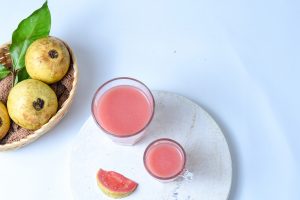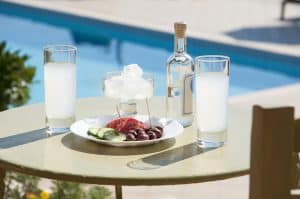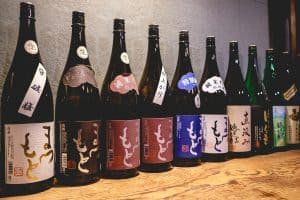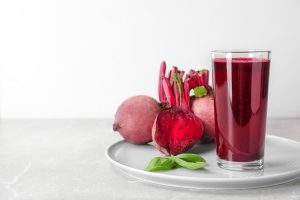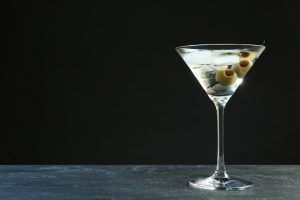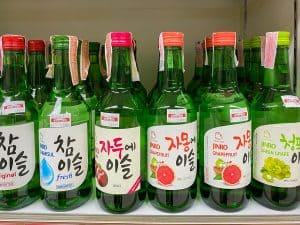
If I got a dollar every time people asked, “is it the same as sake?” When I told them about soju, I’d own a sake store. Soju and sake, although alike, have quite a few differences.
Both spirits are made from rice and are alcoholic, so what exactly is the difference between soju and sake?
The most important difference between these two drinks is that soju is a traditional Korean liquor while sake is Japanese. Soju is drunk more like vodka because it has a higher alcohol content, while sake is drunk more like wine.
Let’s explore all the differences between these two drinks in great detail, shall we?
Differences Between Soju & Sake Explained

Soju is a colorless, distilled liquor made from grains such as rice, barley, wheat, or sweet potatoes. Soju was originally made with only rice, but when the Korean government banned the use of rice to make alcoholic beverages in the 1900s, manufacturers had to adapt and use other ingredients for the production of soju.
Sake, on the other hand, is a fermented alcoholic beverage made from rice. The end product is usually a colorless or slightly yellow liquor.
To understand how sake differs from soju, let’s talk about fermented drinks in general. Most fermented drinks have 3 processes, the ingredient, the brewed form, and distilled form.
For soju, the ingredient is rice or other grains, the brewed form is makgeolli, and distilled form is soju. For sake, it’s rice, sake, and shochu. To put it in perspective, beer made from grains is later distilled to make whiskey.
Unlike fruits like grapes that ferment immediately because of their availability of natural sugars, grains don’t ferment easily because their sugars aren’t readily available.
So the objective of brewing is to convert grain starch to sugar, extract the sugar with water, and ferment it with yeast.
Distillation then ensues to separate the pure alcohol from water and other components in the beer, hence the higher alcohol content. Distillation obtains the alcohol in a pure enough form to make vodka and other high-alcohol spirits.
- Sake is brewed while soju is distilled, so the comparison isn’t fair enough. We should compare sake and makgeolli or soju and shochu.
- Soju has a higher alcohol content than sake, ranging from 20-53% alcohol by volume. Sake has a lower alcohol content than soju, usually around 15-20% alcohol by volume.
- Soju is more affordable, making it the drink of choice for casual drinking occasions. Sake, on the other hand, is more expensive and is traditionally served on special occasions in japan, but it’s getting readily available around the globe as you may find a bottle of sake at your nearest grocery store.
The Taste
Soju has a mild, clean taste with a hint of sweetness. It has a gentle, smooth flavor that is slightly sweet and slightly sour. It also has a slightly herbal, grassy flavor with a hint of fruitiness if flavored. In essence, soju tastes like a sweeter, more diluted vodka.
The flavor of sake can be divided into two main categories: sweet and dry. Sweet sake has a fruity, floral, and light taste, while dry sake has a more earthy, mineral, and savory flavor profile. The sweetness in sake is created by adding more rice during fermentation, and the dryness is created by adding less.
Serving and Drinking Soju and Sake
Soju is traditionally served neat or on the rocks and can also be used in a variety of cocktails. It is commonly mixed with beer, fruit juices, or soda to create a popular Korean drink called a “soju bomb.”
Sake is best served cold or at room temperature. It is important to pour sake into a cup from a bottle rather than drinking it directly from the bottle for temperature reasons. If you’re with company, it’s proper etiquette to pour each other a cup of sake.
For more tips on drinking sake, check out our nigori sake guide.
Production Processes of Soju and Sake
Want to know how rice is converted to soju or sake? Here’s a brief explanation of both processes.
Soju
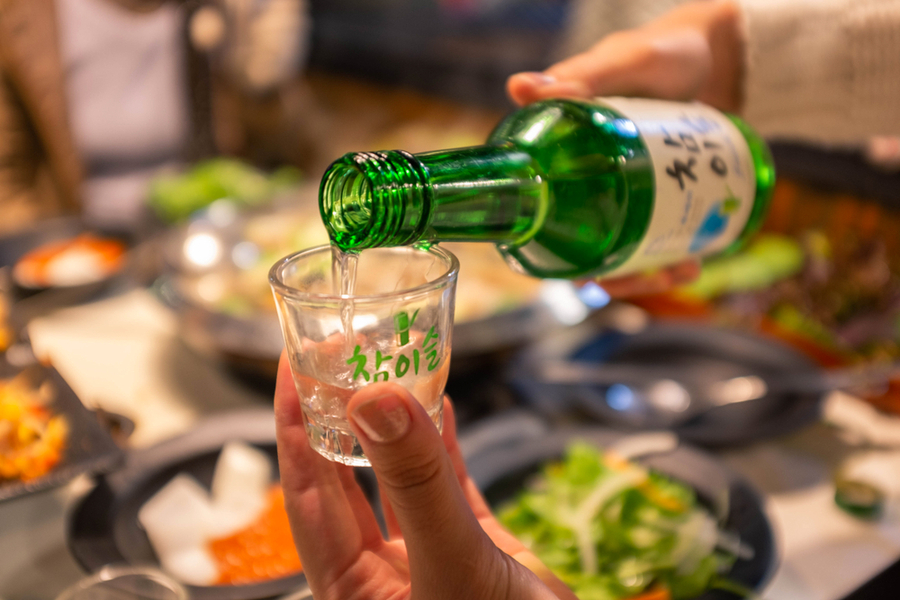
The production of soju begins by combining a starter culture called Nuruk with water, the resulting mash is then molded into a wheat cake and left to ferment for a few days. When it’s done fermenting, it’s added to steamed grains. The grains are usually barley, wheat, sweet potatoes, rice, or tapioca.
The mash is then left to ferment for several days. Once fermentation is complete, the mash is distilled to increase the alcohol content. The resulting liquid is filtered and then pasteurized to stabilize its flavor. Finally, it is bottled and ready for consumption.
Depending on the type of soju being produced, other ingredients such as sugar, flavorings, and sweeteners may be added to give the final product a distinctive taste. Here’s a more descriptive explanation.
Sake

The first step in the production of sake is to mill the rice. This is done to remove the outer layers of the rice grain while preserving the starchy interior, which will later be converted to sugars. The milling process is necessary to create sake that has a high enough alcohol content.
Once the rice has been milled, it is soaked and washed to remove any impurities and increase the water content. The soaking water is then drained off, and the rice is allowed to rest for a few hours.
The soaked and washed rice is then steamed, which helps to soften the grains and makes them easier to break down into sugars.
Next, a special type of mold, known as kōji, is added to the steamed rice. This helps to break down the starch into sugars, which will later be used to create alcohol.
The next step is to create a yeast starter or shubo. This is done by adding yeast and a small amount of steamed rice to water and allowing it to ferment.
Once the shubo is ready, it is added to the steamed rice and kōji mixture. This is then allowed to ferment for several days, and the sugars are converted to alcohol.
The fermented mixture is then pressed to separate out the liquid, or sake. This liquid is then filtered and pasteurized to ensure it is safe for consumption. Once it’s tested for quality, it is ready to be bottled and sold. Unlike whiskey, sake doesn’t need to be aged, it’s best drunk young.
Final Thoughts
Although soju and sake have many things in common, these drinks represent different countries with years of history. To recap, soju is south Korean, while sake is Japanese, soju has more alcohol content because it goes through distilling, while sake is only brewed.
Now you know better than to interchange these two drinks again.

